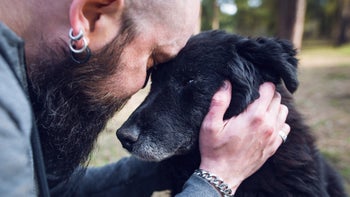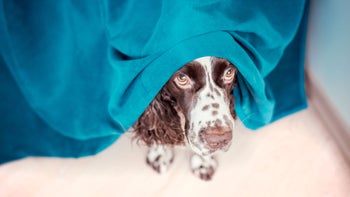
How Much Does Cherry Eye Surgery Cost for Dogs? Plus, 6 Ways to Save Money
Key takeaways:
The average cost of cherry eye surgery for dogs ranges from $300 to $2,500. A dog’s breed and size, the severity of their condition, and how many eyes are affected all affect the total cost.
Other factors, such as preanesthetic blood work and postoperative medications, may increase the cost. Ask your veterinary ophthalmologist what’s included in the price of the surgery and what additional expenses to expect.
You can save money on your dog’s cherry eye surgery by using pet insurance. You can also compare quotes from veterinary ophthalmologists to find the best price and raise money through crowdfunding.

Ever notice a red bump in the inner corner of your dog’s eye? It could be a sign of what’s known as cherry eye. This condition results in a swollen mass protruding from the inside of a dog’s lower eyelid.
If your veterinarian confirms your dog has cherry eye, the best treatment is surgery. The cost of the surgery can range from hundreds to thousands of dollars. What you’ll pay depends on factors such as your dog’s breed and the severity of their eye condition.
There are ways to save money on cherry eye surgery. Some of the options include using pet insurance, comparison shopping, and asking for donations.
Search and compare options
What is cherry eye in dogs?
Cherry eye happens when a dog’s nictitating membrane gland bulges from the inner corner. The prolapse of the gland has a reddish appearance. Cherry eye is more common in certain breeds, such as bulldogs, beagles, and cocker spaniels.
This condition can occur spontaneously. But it can also be triggered by weak connective tissue, inflammation, or genetics. Treatment usually involves surgical correction. The procedure repositions the prolapsed gland and secures it to prevent recurrence.
How much does cherry eye surgery cost for dogs?
On average, the cost of cherry eye surgery can range from $300 to $2,500. This cost may include charges for:
Preoperative examination
Surgery
Anesthesia
Monitoring
In-hospital aftercare
Additional expenses may include:
Preanesthetic blood work
IV fluid therapy during the procedure
Pain medication or antibiotics for at-home care
Treatment for complications
The Animal Eye Center in Colorado charges $1,200 to $1,600 for correcting cherry eye in both eyes, according to the clinic’s website. Eye Specialists for Animals, another practice based in Colorado, quotes a range of $1,500 to $1,900. Though, internal claims data from MetLife, which provides pet insurance, shows that the surgery can cost around $300 to $800.
Read more like this
Explore these related articles, suggested for readers like you.
Keep in mind that some quotes may not include the cost of the initial consultation, medications, and other treatment expenses. It’s important to ask veterinary ophthalmologists what’s included in their quotes, so you can better compare costs at different facilities.
What factors affect the cost of cherry eye surgery?
The total price you’ll pay for cherry eye dog surgery depends on many factors, including:
The severity of the condition: In some cases, a simple surgical correction may be sufficient. More complex or advanced cases may require specialized techniques, leading to higher costs.
Your dog’s breed: Some breeds have a higher risk of developing complications or recurrence after surgery. This factor may necessitate additional postoperative care and follow-up visits.
Your dog’s size: Larger dogs generally have larger eye structures. This means that the procedure may require more time, resources, and specialized equipment.
Your location: The cost of veterinary services can fluctuate based on the region or country where they’re given. Services in urban areas generally have higher price tags than those in rural areas.
Your veterinary ophthalmologist: In addition to a veterinary opthamologist’s experience, their practice and its reputation may also impact the cost. More experienced or specialized surgeons may charge higher fees.
The number of eyes affected: When both eyes are affected, the complexity and duration of the surgery may increase. Also, postoperative care for two eyes may require more medications, monitoring, and follow-ups.
Does pet insurance cover cherry eye surgery?
Comprehensive pet insurance often covers cherry eye surgery because these plans tend to include coverage for necessary medical procedures. The coverage depends on the terms and conditions of the specific policy but may include the following:
Exam fees
Anesthesia
Follow-up care
Take-home medications
Most pet insurance plans don't cover preexisting conditions, and some insurers may limit coverage if a dog’s cherry eye is considered hereditary. Factors such as waiting periods and annual or lifetime limits may also affect reimbursement.
What happens if cherry eye is left untreated?
Left untreated, cherry eye can lead to various complications and potential health issues. The nictitating membrane and its gland are crucial to maintaining eye health. Problems that may arise from not treating cherry eye include:
Dry eye syndrome: If cherry eye is left untreated, the affected eye may not produce adequate tears, resulting in dry eye syndrome. Dry eye syndrome can lead to discomfort, inflammation, and potential corneal damage.
Irritation and discomfort: The exposed gland may become vulnerable to irritation and potential injury.
Increased risk of infections: The exposed gland and surrounding area are more susceptible to infections. The condition may worsen and require more extensive treatment.
Chronic conjunctivitis. Untreated cherry eye can contribute to chronic inflammation of the conjunctiva.
These conditions could lead to additional costs because of the eye drops, topical ophthalmic antibiotics, and steroid-containing medications that may be needed for treatment.
How can I save money on cherry eye surgery for my dog?
Cherry eye surgery for dogs can be costly depending on the factors mentioned above. Here are some ways to reduce the price of your dog’s cherry eye surgery:
Use pet insurance. Most pet insurance plans cover a range of medical expenses, including surgical procedures. If your dog had cherry eye before you bought insurance, there may be limitations or exclusions, however.
Ask your veterinarian. Some veterinarians accept client donations for a reserve fund. These funds are designed to help those with financial challenges.
Request assistance. Rescue groups, shelters, and veterinary colleges may also have funds to help people with the costs of veterinary care.
Research rescue groups. Breed-specific rescue groups may provide financial assistance programs, grants, and direct funding to pet owners who need help with the cost of surgery.
Look into crowdfunding. Consider using a fundraising platform like GoFundMe to establish a personalized fundraising page. Waggle is a platform that directs funds to verified veterinarians to support a pet's care.
Compare veterinary ophthalmologists. Different veterinary ophthalmologists may charge varying fees for the same procedure. By obtaining quotes from multiple specialists, you can identify the most cost-effective options.
Here are some financing options to better manage your veterinary bills:
Pet savings accounts: Establishing a pet savings account lets you budget for your pet's healthcare expenses. You can accumulate funds to reduce financial strain when unexpected medical issues arise.
Credit cards: You can use a medical credit card for various healthcare expenses, including veterinary procedures. Read the terms and conditions, including interest rates and repayment periods, for any cards you’re considering.
Payment plans: Discuss the possibility of a payment plan with veterinary ophthalmologists. Some specialists may offer flexible payment arrangements. Scratchpay also provides payment plans for medical financing, including for veterinary services.
The bottom line
Cherry eye surgery can cost anywhere from $300 to more than $2,000, depending on your dog’s breed and the severity of their condition. It’s a good idea to speak with several veterinary ophthalmologists to evaluate how their fees compare and to understand what extra costs you might incur.
If you have pet insurance, check your policy for coverage, requirements, and restrictions. You can also review prices at veterinary colleges and look into payment plans to help you afford cherry eye surgery.
Why trust our experts?



References
Animal Eye Center. (n.d.). Pricing.
ASPCA Pet Health Insurance. (n.d.). Pet insurance and pre-existing conditions.
Embrace Pet Insurance. (n.d.). Pet insurance for surgery.
Eye Specialists for Animals. (n.d.). Cost of surgery / treatment.
Khuly, P. (n.d.). Conjunctivitis. Embrace Pet Insurance.
Khuly, P. (n.d.). Keratoconjunctivitis sicca (dry eye). Embrace Pet Insurance.
MetLife Pet Insurance. (2023). Cherry eye surgery cost: What to expect.
Mosunic, C. B. (n.d.). Cherry eye. American College of Veterinary Ophthalmologists.
Pal, M. (2024). How much does cherry eye surgery for dogs cost? (2024 guide). Forbes.
Sleight, M. (2023). What does pet insurance cover? U.S. News & World Report.
The Humane Society of the United States. (n.d.). Are you having trouble affording your pet?


























